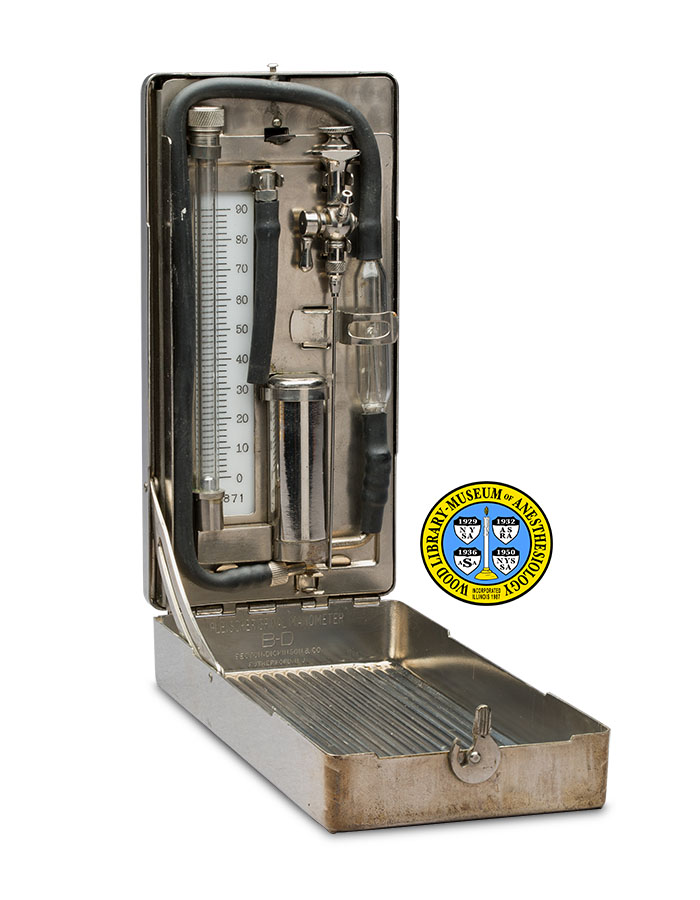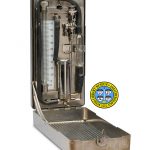Fleischer Spinal Manometer
Cerebrospinal fluid (CSF) circulates within and around the brain and spinal cord. Intracranial pressure (ICP) is a measurement of both the pressure within the brain and CSF pressure. Anesthetics and other drugs can cause changes in these pressures. The technique of lumbar puncture, also called spinal tap, was introduced in 1891. The procedure is used to collect a small sample of CSF from the patient's lower spine for purposes of diagnosis. Lumbar puncture is also used to administer some medications, including local anesthetics.
The first clinical spinal manometer was introduced in 1905. These devices used lumbar puncture to determine ICP and CSF pressures. The Fleischer Spinal Manometer was introduced by Chicago businessman A. W. Fleischer in 1921, the same year that his company merged with the New Jersey medical equipment manufacturer, Becton Dickinson (B-D). His spinal manometer was made by B-D through the mid-1960s. New technologies for continuous monitoring of ICP came into widespread use in the 1970s, taking the place of lumbar puncture for determining pressures.
Catalog Record: Fleischer Spinal Manometer Fleischer Manometer
Access Key: aqkp
Accession No.: 2017-06-19-1
Title: Fleischer’s Spinal Manometer / Becton Dickinson.
Corporate Author: Becton, Dickinson and Company.
Publisher: Rutherford, NJ : Becton, Dickinson and Company, [between 1921 and 1963].
Physical Description: 1 spinal manometer : metals, rubber, glass, plastic, mercury; 8.5 x 18 x 20 cm.
Subject: Cerebrospinal Fluid Pressure – instrumentation.
Subject: Intracranial Pressure – instrumentation.
Subject: Spinal Puncture – instrumentation.
Note Type: General
Notes: The title is taken from the object. Mr. A. W. Fleischer was proprietor of Physicians Specialty Company, in Chicago. He is believed to have been the inventor of several medical instruments that bore his name and which were sold by that company.
Note Type: General
Notes: The first year in the date range is based on the year that Physician’s Specialty Co. merged with Becton Dickinson. The second year in the date range is based on the date of the donor’s death; the actual date of manufacture is likely to have been some years earlier.
Note Type: General
Notes: The review in the American Journal of Neurology and Psychiatry of the 1881 monograph by von Naunyn and Schreiber constitutes an English-language abstract. The monograph describes experiments on the subarachnoid space in animals, and the use of a spinal manometer for that purpose. The authors refer to their work as an extension of experiments on the subdural space in animals conducted by Pagenstecher, Leyden and Duret, as well as those “undertaken in Marey’s laboratory five years ago” by Salathé.
Note Type: Citation
Notes: Aloe Medical. Supplies Catalog No. 210. St. Louis: Aloe Medical, Division of Brunswick Corp., 1964:192.
Note Type: Citation
Notes: American Surgical Trade Association Journal. November, 1921;9(1): 35.
Note Type: Citation
Notes: Artu AA. Cerebrospinal fluid: physiology and pharmacology. In: Sperry RJ, Johnson JO, Stanley TH. Anesthesia and the Central Nervous System. Dordrecht, The Netherlands: Kluwer Academic Publishers, 1993:27-49.
Note Type: Citation
Notes: Artu AA. Cerebrospinal fluid. In: Cottrell JE, Patel P, eds. Cottrell and Patel’s Neuroanesthesia, 6th ed. Edinburgh: Elsevier, 2017:59-73.
Note Type: Citation
Notes: Becton Dickinson Company File. Archives. Located at: Wood Library-Museum of Anesthesiology, Schaumburg, Illinois.
Note Type: Citation
Notes: Brock M, Dietz H, eds. Intracranial Pressure : Experimental and Clinical Aspects. Berlin: Springer Verlag, 1972.
Note Type: Citation
Notes: Medscape.com website. Intracranial Pressure Monitoring. http://emedicine.medscape.com/article/1829950-overview. Accessed October 3, 2017.
Note Type: Citation
Notes: Ueber gehirndruck von Naunyn und J. Schreiber in Konigsberg in Presusen, mit 7 curventafeln. Leipzig: F. C.W. Vogel, 1881. [Review Department]. American Journal of Neurology and Psychiatry. 1882;1:63-67.
Note Type: Citation
Notes: Warner DS, Sokoll MD. Monitoring intracranial pressure. In: Blitt CD, ed. Monitoring in Anesthesia and Critical Care Medicine, 2nd ed. New York: Churchill Livingstone, 1990:525-538.
Note Type: Physical Description
Notes: One spinal manometer; Consists of a hinged chrome case containing a manometer and a lumbar puncture needle; The lid and the bottom of the case are embossed with striations; The lock on the case consists of a sickle-shaped latch; The dimensions given in the short physical description are those with the case open; When the case is closed it measures approximately 3.25 x 8.25 x 17 centimeters;
The manometer is mounted Inside the lid; On the left there is a glass tube containing a bead of mercury; This glass tube is connected at metal block that is in turn connected to a short metal cylinder to the right; Beneath this glass tube, and extending to the right of it, a white plastic gauge is marked, from top to bottom: “90, 80, 70, 60, 50, 40, 30, 20, 10, 0” and “S 6871”;
The short metal cylinder is connected to a short length of rubber tube; This tube leads upward to the bottom of a glass bulb; This glass bulb is held in place by a metal clip; The opposite end of the bulb is connected to a longer piece of rubber tube; This longer tube ends in a metal connector; Between the plastic gauge and the cylinder a third, short rubber tube is held in place by a metal clip; Immediately to the left of the glass bulb another metal clip holds the needle;
Inside the bottom section of the case, the side wall directly under the hinge is marked: “FLEISCHER’S SPINAL MANOMETER [new line] B-D”; A loose label printed on card stock lines the bottom of the case; This label reads: “CAUTION [new line] Before using this instrument, unscrew the metal cap on top of the manometer tube and remove the black leather disc. Do not remove any other parts; [new line] The metal cap should retain permanently, a metal gauze disc; a special (light colored) leather disk and a cork washer. [new line] PRECAUCION [new line] Antes de usarse el instrumento debe destornillarse la tapa de metal del tubo del manometro y sacarse el disco de cuero negro. No saque ningun otro disco. [new line] La tapa de metal debe tener permanentemente el disco de gasa metalica, el disco especial de cuero claro, y el de corcho. [new line] BECTON, DICKINSON & Co. [new line] RUTHERFORD, N. J.”;
A tag on card stock, printed in red, reads: “DO NOT USE [new line] INSTRUMENT BEFORE [new line] READING INSTRUCTIONS [new line] A black leather disc has been placed inide the metal cap on top of the glass manometer tube for security in shipping. [new line] Before using the instrument unscrew the metal cap, remove the black leather disc only and replace cap, screwing down tightly. Do not remove the other contents of the cap. [new line] Becton, Dickinson & Co. [new line] Rutherford, N. J. [new line] Printed in U. S. A. D5025T”.
Note Type: Reproduction
Notes: Photographed by Mr. Steve Donisch, June 19, 2017.
Note Type: Acquisition
Notes: Gift of Paul M. Wood, M.D.
Note Type: Historical
Notes: Cerebrospinal fluid (CSF) is produced in the brain. It circulates inside the brain and spinal cord, as well as around them. First described in ancient times, scientific study of CSF began in the Age of Enlightenment. By the mid-19th Century spinal manometers were being used to measure CSF pressure during experiments. Perhaps the first spinal manometer for use in monitoring and diagnosing human patients was introduced in 1905 by British physician Frank C. Eve, M.D. In the 1920s, several models of spinal manometer were available and their use became commonplace.
In 1885, American physician James Leonard Corning (1855-1923) introduced the technique of spinal anesthesia. This involves the injection of anesthetics into the lower spine in order to numb a region of the body. Six years later, the modern technique of lumbar puncture, also called a spinal tap, was introduced by the German physician, Heinrich Quincke (1842-1922). The procedure can be used to collect a small sample of CSF from the patient’s lower spine for purposes of diagnosis. Lumbar puncture is also used to administer some medications, including regional anesthetics. Another site for the injection of anesthetics is the subarachnoid space, between the skull and the brain. Anesthetics and other drugs can bring about changes in CSF pressure.
Mr. A. W. Fleischer was proprietor of Physicians Specialty Company, in Chicago. He is believed to have been the inventor of several medical instruments that bore his name and which were sold by that company. One of these was the Fleischer Spinal Manometer. Others included the Fleischer Anscultoscope, Fleischer Orifiscope and Fleischer Stethoscope. Publications dating from 1894 through 1921 evidence companies named Physicians Specialty doing business in Delaware, Illinois, Maine, New York, Pennsylvania and Virginia. The cataloger found records of the company’s presence in Chicago, IL, dated from 1907 through 1921.
In 1921, it was announced that Mr. Fleischer had merged his firm with the medical equipment manufacturer Becton Dickinson Company (B-D). Becton Dickinson was founded in New York in 1897. By 1912, it had relocated to Rutherford, New Jersey. B-D is currently headquartered in Franklin Lakes, New Jersey. Mr. Fleischer joined B-D as manager of a new Diagnostic Instruments division. This announcement contains the earliest reference to the Fleischer Spinal Manometer found by the cataloger. The manometer and/or its associated needle were also found in B-D and other manufacturers’ catalogs dating from 1923 through 1964, where the name is sometimes spelled “Fleisher”.
The Fleischer spinal manometer was made by B-D through the mid-1960s. It could be used to measure either CSF alone, or, by repeated measurements, to determine the pressure within the skull (intracranial pressure, or ICP.) Elevated pressure in the brain and cerebrospinal fluid can indicate certain diseases as well as injury. Continuous monitoring of ICP began in the 1950s, and came into widespread use in the 1970s, taking the place of lumbar puncture for diagnostic purposes.
Note Type: Publication
Notes: Becton Dickinson. Celebrating the first on hundred, 1897-1997: Becton Dickinson and Company. Rutherford, New Jersey: Becton Dickinson, 1997.
Note Type: Publication
Notes: Block EB, Oppenheimer RH. A comparative study of intraspinal pressure, blood pressure and intra-ocular tension. JAMA. Arch NeurPsych, 1924;11(4):444-447.
Note Type: Exhibition
Notes: Selected for the WLM website.


